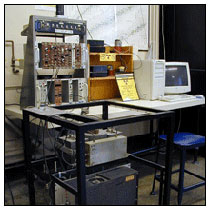|


Determination of the relation
between the half-lives and alpha-particle energies
of the emanations of urananite. The energies of
alpha particles emitted by the radioactive emanations
of the mineral urananite and their decay products
are measured with a solid state detector. Next,
radon, milked from the urananite and adsorbed
on charcoal, is extracted with liquid scintillator
and counted in a scintillation counter.
The rates of the various alpha
particle decay processes of radon and its daughter
nuclei are then measured as functions of time,
and the mean lives of the various nuclei are deduced
from the data according to the Bateman equations.
The relation between the measured mean lives and
the decay energies is compared with the theoretical
relation derived according to the quantum mechanical
tunneling theory of alpha decay. Finally, the
range-energy relation of alpha particles is determined
from a measurement of the residual energies of
alpha particles as a function of the thickness
of air traversed.
Student Wiki: Quantum Mechanics of Alpha Decay
Download
Lab Guide in PDF format
(certificates
required)

- R.W. Gurney, and E. W. Condon, "Wave
Mechanics and Radioactive Disintegration", Nature, 122,
439, (1928)
- R. W. Gurney, and E. W. Condon, "Quantum
Mechanics and Radioactive Disintegration", Phys. Rev.,
33, 127-140, (1929)
- E. Bleuler and G.J. Goldsmith, Experimental Nucleonics,
(New York, Rinehart, 1952), "Exp
19: Range and Energy Loss of Alpha Particles; Exp 23: Radiations of Cu(64)
(Zn(65))", pp. 275-282, and 3341-354
- E. Sergè, Experimental Nuclear Physics, (New York,
Wiley, 1953-1959), "Fundamental
Principles of Particle Detection", Vol. I.,
Sec. 1.2, pp. 2-38
- E. Sergè, Experimental Nuclear Physics, (New York,
Wiley, 1953-1959), "Passage
of Heavy Particles through Matter", Vol. I.,
Sec. 2.1B-D, pp.231-252
- I. Perlman and F. Asaro, "Alpha
Radioactivity", Annual Review of Nuclear Science,
4, 157-190, (1954)
- G.G. Manov, "Standardization
of Radioactive Sources", Annual Review of Nuclear Science,
4, 51-68, (1954)
- T.P. Kohman and N. Saito, "Radioactivity
in Geology and Cosmology", Annual Review of Nuclear Science,
4, 401-462, (1954)
- Ritson, D.M., Techniques in High Energy Physics, (New
York, Interscience Publishers, 1961), "General
Properties of Particles and Radiation", Chap. 1,
p. 1-53
- R. Evans, Atomic Nucleus, (Malabar, Fla. : R.E. Krieger,
1982), "Beta-Ray
Spectra", Chap. 17, pp. 536-566
- Knoll, Glenn, "Radiation Detection and Measurement, 3rd Edition, Chapter 11:
Semiconductor Diode Detectors" - (Wiley 2000)
- P. Marcillac, N. Coron, G. Dambler, J. Leblanc, and J-P. Loalic,"Experimental
detection of alpha-particles from the radioactive decay of natural bismuth",
Nature, 422, pp. 876-878, (2003)
- S. Weinberg, The
Discovery of Subatomic Particles, (Cambridge, U.K. ; New York
: Cambridge University Press, 2003), 138

- Table of Isotopes - Lawrence Berkeley Laboratory
- Table of Nuclides - Korea Atomic Energy Research Institute
- PIPS Alpha Particle Detector Model 45020AM
- Maestro software user manual
|